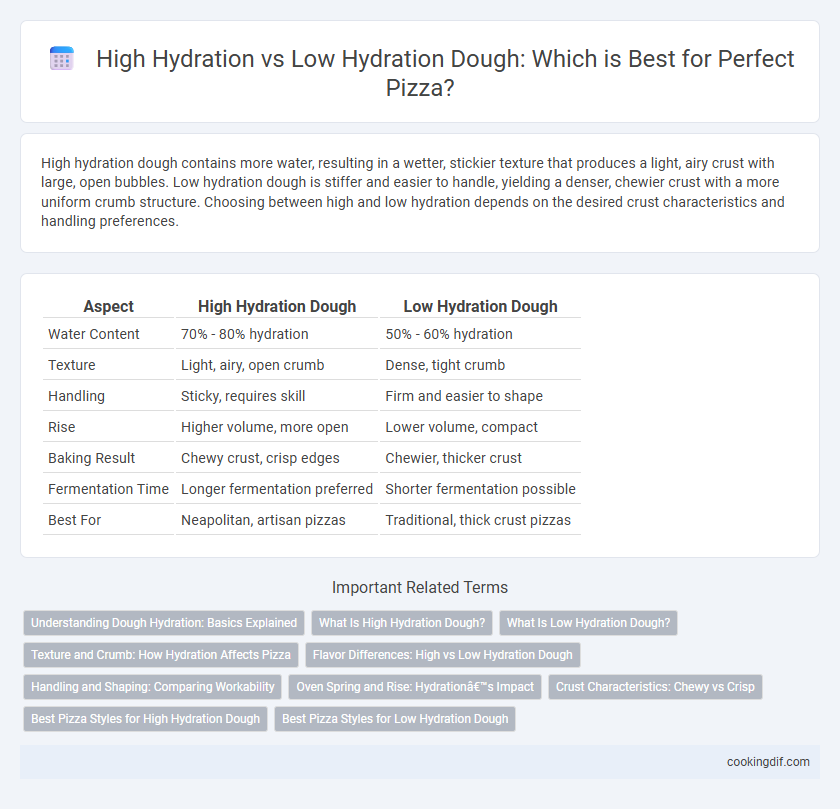High hydration dough contains more water, resulting in a wetter, stickier texture that produces a light, airy crust with large, open bubbles. Low hydration dough is stiffer and easier to handle, yielding a denser, chewier crust with a more uniform crumb structure. Choosing between high and low hydration depends on the desired crust characteristics and handling preferences.
Table of Comparison
| Aspect | High Hydration Dough | Low Hydration Dough |
|---|---|---|
| Water Content | 70% - 80% hydration | 50% - 60% hydration |
| Texture | Light, airy, open crumb | Dense, tight crumb |
| Handling | Sticky, requires skill | Firm and easier to shape |
| Rise | Higher volume, more open | Lower volume, compact |
| Baking Result | Chewy crust, crisp edges | Chewier, thicker crust |
| Fermentation Time | Longer fermentation preferred | Shorter fermentation possible |
| Best For | Neapolitan, artisan pizzas | Traditional, thick crust pizzas |
Understanding Dough Hydration: Basics Explained
Dough hydration refers to the ratio of water to flour, significantly impacting pizza dough texture and elasticity. High hydration doughs, containing 70% or more water, yield a softer, airier crumb with larger holes, ideal for Neapolitan-style pizzas. Low hydration doughs, typically between 55-60%, produce a denser, crispier crust favored in traditional New York-style pizzas.
What Is High Hydration Dough?
High hydration dough contains a high ratio of water to flour, typically above 70%, resulting in a wetter and stickier consistency that promotes a more open crumb structure with larger air pockets. This type of dough enhances gluten development and fermentation, yielding a lighter, chewier pizza crust with a crisp exterior. High hydration dough requires careful handling and longer fermentation times to achieve the characteristic texture and flavor preferred in artisan and Neapolitan-style pizzas.
What Is Low Hydration Dough?
Low hydration dough contains around 50-58% water relative to flour, resulting in a stiff, dense texture ideal for thin, crispy pizza crusts. This type of dough requires less handling and produces a chewier bite with a tight crumb structure. Bakers favor low hydration dough for its ease in shaping and ability to hold toppings without becoming soggy.
Texture and Crumb: How Hydration Affects Pizza
High hydration dough, typically above 70%, produces a lighter, airier crumb with open holes and a chewy texture, ideal for Neapolitan and artisan-style pizzas. Low hydration dough, usually below 60%, results in a denser, tighter crumb with a firmer, crispier crust, preferred for traditional New York-style or thin-crust pizzas. Adjusting hydration levels directly impacts dough extensibility and moisture retention, influencing the final pizza's texture and mouthfeel.
Flavor Differences: High vs Low Hydration Dough
High hydration dough, containing 70% or more water relative to flour, produces a lighter, airier crust with a more open crumb structure and enhanced fermentation that intensifies complex, tangy flavors. Low hydration dough, typically below 60%, results in a denser, chewier crust with a more straightforward, yeasty taste profile and less pronounced sourness. These hydration levels influence Maillard reactions during baking, affecting crust color and flavor depth, making high hydration dough preferred for artisan-style pizzas with nuanced taste.
Handling and Shaping: Comparing Workability
High hydration dough, with water content above 70%, offers increased extensibility and softness, making it more challenging to handle and shape due to its sticky and slack texture. Low hydration dough, typically around 55-60% water, provides firmer structure and easier manipulation, allowing for precise shaping and less risk of tearing. Bakers often prefer low hydration dough for consistent handling, while high hydration dough yields a lighter, airier crust but requires more skill during shaping.
Oven Spring and Rise: Hydration’s Impact
High hydration doughs (70% and above) significantly enhance oven spring by allowing greater gas retention and expansion during baking, leading to a lighter, airier crust with pronounced rise. Low hydration doughs (below 60%) produce a denser, flatter crust with limited oven spring due to reduced water content restricting gluten development and gas retention. Optimal hydration balances elasticity and extensibility, directly influencing dough's ability to rise and achieve desired texture in pizza crusts.
Crust Characteristics: Chewy vs Crisp
High hydration dough, typically containing 70% or more water relative to flour, results in a crust that is chewier and more open-crumbed due to increased gluten development and steam during baking. Low hydration dough, usually around 55-60%, produces a denser, crisper crust with a tighter crumb structure ideal for thin-crust pizzas. Bakers often select hydration levels based on desired crust texture, with high hydration favored for Neapolitan-style pizza and low hydration common in New York-style or cracker-thin crusts.
Best Pizza Styles for High Hydration Dough
High hydration doughs, with water content exceeding 70%, create an open crumb structure and airy texture ideal for Neapolitan and ciabatta-style pizzas. This dough style promotes a tender, chewy crust with characteristic bubbles and a moist, flavorful bite, making it perfect for wood-fired ovens. In contrast, lower hydration doughs, around 55-60%, yield denser crusts favored in New York-style and Sicilian pizzas, emphasizing crispness over softness.
Best Pizza Styles for Low Hydration Dough
Low hydration dough, typically containing 55-60% water, creates a firm and dense crust ideal for traditional pizza styles like Neapolitan and New York-style. This dough type supports a chewy texture with a slightly crisp outer layer, perfect for hand-tossed and thin-crust pizzas. Low hydration dough also simplifies handling and shaping, making it favorable for pizza makers seeking consistent results and classic texture.
High hydration vs low hydration for dough Infographic

 cookingdif.com
cookingdif.com